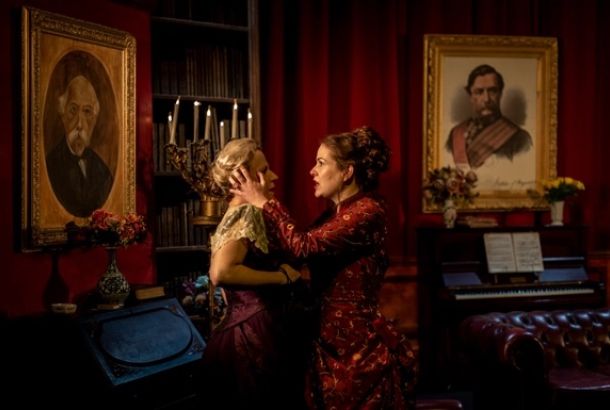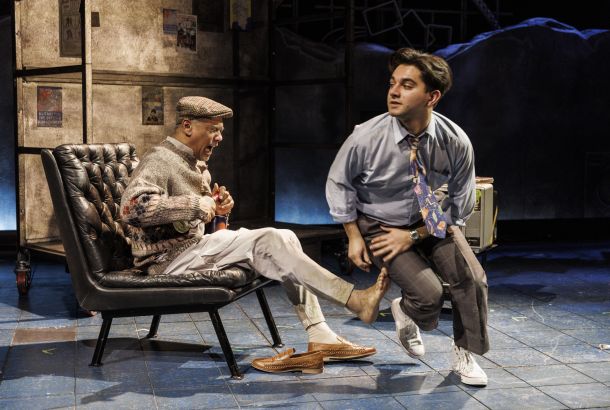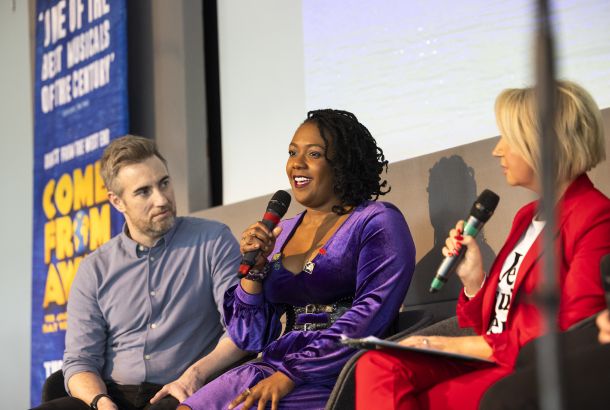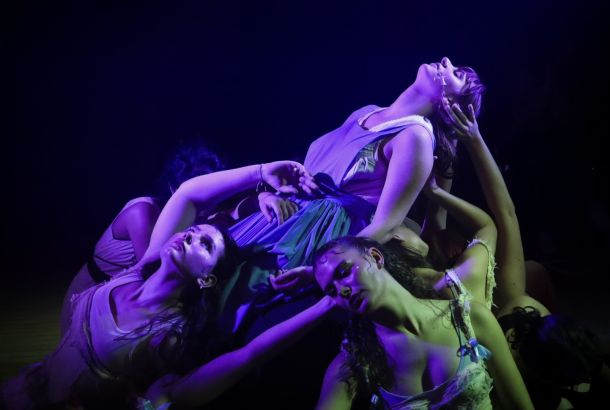
Expectations were high for Drive Your Plow Over the Bones of the Dead. The novel was shortlisted for the 2018 International Brooker Prize, and author Olga Tokarczuk was awarded the 2019 Nobel Prize in Literature. The stage adaptation stars Olivier winner Kathryn Hunter, one of the country’s most acclaimed stars of the stage – and the first British and English-speaking woman to play King Lear professionaly. Oh, and it is one of very few productions to be awarded five stars by Arifa Akbar!
The play, like the novel, follows Janina Duszejko, an eccentric old woman living in a rural Polish village. Janina is still reeling from the disappearance of her two dogs, who she affectionately calls “my girls”, leading others to think she is referring to her children, but that is exactly how she viewed them.
The play begins with Hunter taking to the bare stage and approaching the microphone in the middle of it. At first, it is unclear she is acting; I wondered if she was merely introducing the play. Eventually, Hunter is joined by the ensemble, and the story begins to unfold.
Janina’s neighbour, Big Foot, a frequent hunter, is found dead in his home by Janina’s friend, Oddball. From Janina and Oddball’s inspection of the scene, it seems Big Foot choked on a bone while eating. Janina also finds a shocking photograph in Big Foot’s house. The photograph flashed on the screen at the back of the stage; we saw a group of people but it was far too brief for us to see anything beyond that. The contents of the photo are not revealed until the end of the play.
Janina disliked Big Foot because she disagrees with hunting animals. In fact, Janina views animals as no different to humans. After all, humans are animals. She is repeatedly criticised for valuing animals more than humans.
As other hunters are found dead, Janina begins to believe that animals could have killed Big Foot out of vengeance. But a final twist towards the end of the play changes everything.
The novel uses the trope of the unreliable narrator, à la The Girl on the Train, which Hunter brilliantly captures in her performance. Much of the 3-hour long play is a monologue, with Hunter speaking into the microphone and directly to the audience. It feels as if the novel has come to life.
The mood of the play, like the novel before it, is unclassifiable. It suddenly shifts from comedy to tragedy, from murder mystery to political satire, yet the shifts feel seamless.
The novel explores the value of life by asking which lives matter. Janina stands in opposition to the traditional values of her culture. Most people don’t consider the source of the meat they eat and that an animal was slaughtered to provide it. Even pet animals like dogs or cats become prey if they stray onto a hunter’s property.
The play also interrogates the value we put upon different animals. To the hunters, all animals are fair game (pun unintended but let’s roll with it). But to most people, pets are off-limits. Take, for instance, the Western outrage over the Chinese eating dogs. When Janina confronts the President’s wife about him killing her dogs, she protests, for she believes her husband is incapable of killing a pet – even though, moments earlier, she had wondered if he was responsible for taking the lives of his fellow hunters.
Whilst the first act tackles an abundance of issues, it is not until the second act that the play’s political nature is brought to the forefront. It is not until the second act that we meet “The President”. The moral of the first act appeared to be “don’t eat meat”; it’s in the second act that the play finds it political footing.
I loved the interactive nature of the play. As aforementioned, Janina tells much of the story directly to the audience. On a couple of occasions, other characters speak into the microphone – but the characters are very aware that it belongs to Janina.
The first time this happens, Janina is in a clothes shop. The lovely woman that works there has a condition where she has no hair. Janina stands at the microphone with the hairless lady speaking to her almost silently. Janina is removed from the scene, talking into the microphone, relaying the information onto the audience. She soon says something along the lines of, “Actually, why don’t you?”, inviting the kind lady to tell her own story.
On the second occasion, it becomes more direct, with Janina’s lover-to-be asking her if he may. “It’s my microphone,” she tells him, before relenting.
The third occasion takes things even further, with the President straightup pushing her out of the way and colonising the mic.
Techniques like this help create a whimsical mood to the play. It felt a little surreal. It was as if we were being reminded that this is not real life – but it is a reflection of real life.
Indeed, the production has a huge mirror at the top-back of the stage on a couple of occasions. The first act ends, and the second act opens, with the mirror, forcing the audience to see their own reflection. We are asked to reflect – literally. The play raises moral questions that we, the audience, must answer.
The play’s stage design is dazzling. The staging is pretty simple. There is a huge screen at the back of the stage, on which a wide array of images are projected, from mere scenery to video images of some of the cast, capturing their inner-emotions.
At times, there is a black wall towards the back of the stage, with a huge, floor-length window in the middle, allowing us to see the projections on the screen at the back. The window, itself, has images projected on to it, creating a multi-layered landscape. One of the best uses of this is the scene in the church. The screen at the back displays the inside of the church. Later in the scene, the window appears and turns into a stained-glass window, with rays of colour beaming at it. It’s a visual feast.
These are but a few excellent examples of the play’s visual storytelling.
The costumes are pretty simple but there are some pretty stunning animal masks. Humans portray animals which seems to be a reminder that humans are animals – and, arguably, no better than other animals. There’s even a costume party in which guests are asked to dress as animals, which could be a critique of humans using animals for our own pleasure, with very little consideration for their wellbeing.
I could go on and on and on but I’ve given enough away – and surely, by now, you’re sold.
A political thriller, a murder mystery, a dark comedy, and a visual feast – this is a play like no other.
Drive Your Plow Over the Bones of the Dead runs at The Lowry (Lyric Theatre) until April 29, the final stop of its UK tour. It then tours mainland Europe (surprisingly, not Poland) until June 17.







